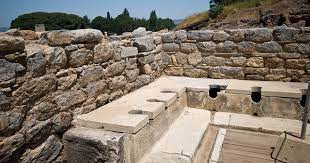
When we think of ancient Rome, grand monuments, bustling streets, and impressive architecture often come to mind. However, there’s one aspect of daily life in ancient Rome that isn’t frequently discussed but was an essential part of urban infrastructure: public toilets. These facilities, known as latrines, played a crucial role in maintaining public hygiene and sanitation in the bustling city. Despite their importance, the reality of using public toilets in ancient Rome was far from glamorous. Let’s dive into the less-than-pleasant world of ancient Roman latrines and explore the fascinating archaeological evidence that sheds light on this essential yet often overlooked aspect of daily life.
The Unsanitary Reality of Ancient Roman Latrines

- Design and Structure: Ancient Roman latrines were typically large communal spaces located in public buildings, marketplaces, or along busy streets. These facilities featured rows of stone or marble benches with strategically placed holes, often without partitions between users. Waste would fall directly into a channel below, which was flushed out periodically with water from nearby aqueducts or manually by attendants. The lack of privacy and ventilation meant that using these latrines was not a pleasant experience, and the stench would have been overwhelming.
- Social Dynamics: Despite the unsanitary conditions, public latrines were essential gathering places where people from all walks of life would come together to relieve themselves, socialize, and conduct business. These communal spaces provided an opportunity for conversation and gossip, transcending social barriers and fostering a sense of community among Roman citizens. The egalitarian nature of public latrines meant that senators and commoners alike would share the same facilities, albeit with varying levels of discomfort.
- Hygiene and Sanitation Practices: While public latrines served a vital function in managing human waste, hygiene and sanitation practices in ancient Rome were rudimentary compared to modern standards. Toilet paper as we know it did not exist, so Romans would use sponges attached to sticks or simply their hands to clean themselves. Afterward, they might rinse off in a communal basin or use a sponge soaked in vinegar. Despite these efforts, the spread of diseases and parasites was common, contributing to the high mortality rate in ancient Rome.
- Archaeological Evidence: Archaeological excavations have uncovered numerous public latrines throughout the former territories of the Roman Empire, providing valuable insights into ancient sanitation practices. These excavations have revealed the layout and construction of latrines, as well as artifacts such as pottery, coins, and personal hygiene items. By studying the archaeological remains of public latrines, historians and archaeologists gain a deeper understanding of daily life in ancient Rome and the challenges faced by its inhabitants.
Reflecting on Ancient Sanitation

In conclusion, public toilets in ancient Rome may not have been glamorous, but they played a crucial role in maintaining public hygiene and sanitation in a bustling urban environment. Despite the less-than-ideal conditions, these communal facilities served as social hubs where people from all walks of life would come together, albeit uncomfortably, to attend to their basic needs. Through archaeological excavations and research, we continue to uncover the realities of ancient sanitation practices, shedding light on the daily lives of our predecessors and the challenges they faced in managing waste and maintaining public health.








